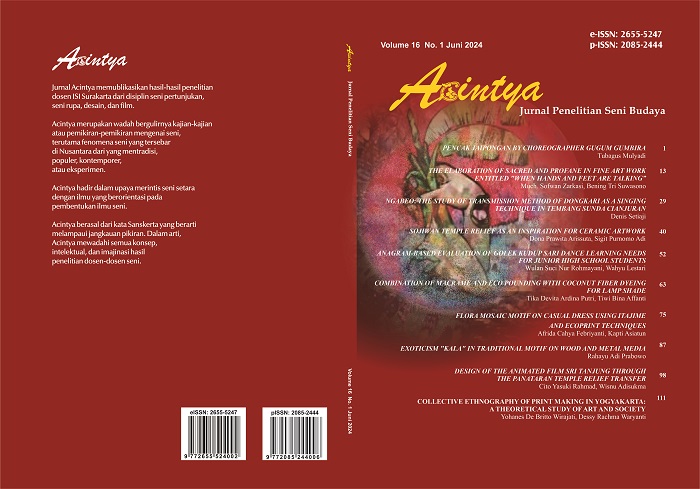SOJIWAN TEMPLE RELIEF AS AN INSPIRATION FOR CERAMIC ARTWORK
DOI:
https://doi.org/10.33153/acy.v16i1.5643Keywords:
Monkey and Crocodile Relief, Sojiwan Temple, Life Learning, Reception Theory, Ceramic ArtAbstract
This study explores the reception of monkey and crocodile figures depicted on one of the relief panels of Sojiwan Temple in Klaten, Central Java, Indonesia. The Sojiwan Temple reliefs visualize fairy tales from the Jataka, a collection of fables that often convey contextual and didactic themes. Through the lens of reception theory, this study identifies life lessons such as intelligence, dexterity, impartiality, and wisdom from the narrative panels of Sojiwan Temple and transforms them into ceramic art. Three ceramic artworks inspired by the monkey and crocodile reliefs highlight the notion that even a simple fairy tale does not possess a single, fixed meaning. Instead, there is a progressive interpretation that evolves with each reading of the reliefs at Sojiwan Temple. This research concludes that ceramics can serve as a medium to convey diverse interpretations, thereby enriching the aesthetic appreciation of the monkey and crocodile reliefs at Sojiwan Temple.
Keyword: Monkey and Crocodile Relief, Sojiwan Temple, Life Learning, Reception Theory, Ceramic Art
Downloads
References
Adi, S. P., & Isnanta, S. D. (2021). Katalog Pameran Estetika Sanggit. In R. A. Sugihartono & Zuliati. (Eds.), ISI Surakarta. ISI Press Solo.
Appletton N. (2010). Jataka Stories in Theravada,.
Ibrahim, M. (1996). Kompleks Candi Prambanan dari masa ke masa. Direktorat perlindungan dan pembinaan peninggalan sejarah dan purbakala.
S, C. (2016). Reading Vessantara Jataka. (New York : Columbia University Press).
Soekmono R. (1995). The Javanese Candi.
Wimpenny. (2021). Aesop’s Animal: The Science Behind the Fables.
Astuti Ambar, Pengetahuan Keramik. Yogyakarta. Gadjah Mada University Press. 1997.
Isa Darmawijaya, M., (1997). Klasifikasi Tanah, Yogyakarta, Gadjah Mada University Press.
Tim Wacana Nusantara, Gerabah: Peninggalan Kebudayaan Masyarakat Prasejarah, www.wacananusantara.org,2009.
Setiabudi, Natas. 2011. Belajar Sendiri Membuat Keramik. Bandung: Bejana.
Bischofberger Bruno, Ettore Sottsass. Ceramics. Chronicle. Switzerland. 1995
Razak, R.A. Industri keramik. Jakarta.Balai Pustaka:1993.
Downloads
Published
How to Cite
Issue
Section
License
Copyright (c) 2024 Dona Prawita Arisutta, Sigit Purnomo Adi

This work is licensed under a Creative Commons Attribution 4.0 International License.
Author continues to retain the copyright if the article is published in this journal. The publisher will only need publishing rights




